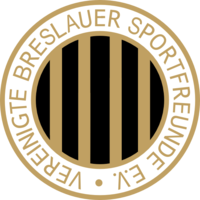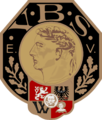United Wroclaw Sports Friends
| United Wroclaw Sports Friends | |||

|
|||
| Full name | United Breslauer Sportfreunde e. V. |
||
| place | Wroclaw | ||
| Founded | 1904 | ||
| Dissolved | 1933 | ||
| Club colors | Black-white-yellow | ||
| Stadion | South park | ||
| Top league | Gauliga | ||
| successes | 7 participations in the final round of the German championship , 6 times Southeast German champion |
||
|
|
|||
The United Breslauer Sportfreunde were a German football club from the Lower Silesian Breslau .
history
The United Breslauer Sportfreunde was founded in 1904 under the name SC 1904 Breslau . In 1910 the chairmanship of the association was taken over by the Jewish merchant and art collector Leo Lewin , who wanted to turn the association into a top club that could also keep up at the national level. Due to the temptation to become a professional player , Lewin had paid some players sums of money for games, the club was disqualified for three seasons after an extraordinary association meeting of the SOFV on January 15, 1911. This suspension was subsequently shortened to October 1, 1911, four players were declared professional players and then disqualified, Leo Lewin was suspended for five years for being tempted to play professional games. On January 8, 1912, the name was changed to Club Breslauer Sportfreunde . In 1912 the national player Camillo Ugi switched to Sportfreunde, and he was given the prospect of having his own workshop for the production of cinematographs. In the south-east German soccer championship 1913/14 the club reached the final, which however was lost 1: 3 against FC Askania Forst . After the First World War , the merger with SC Preußen Breslau to United Sportfreunde Breslau took place in 1919 .
In the 1920s , the club was one of the leading teams in the Southeast German Football Association and was able to win the Southeast German championship five times in a row between 1920 and 1924. This time was also marked by a rivalry with FC Viktoria Forst , both clubs regularly met in the finals. In 1920 , Breslau won the final of the Southeast German Championship 6-2 against Viktoria Forst and thus qualified for the first time for the final round of the German Championship. In this , the Sportfreunde defeated the Union Oberschöneweide 3-2 in Breslau in the quarter-finals , but retired after a 0-4 against SpVgg Fürth in Leipzig. In 1921 , the United Breslau Sportfreunde again met FC Viktoria Forst in the final of the Southeast German Championship . This time too, the Breslau team prevailed, the game ended 2-1 after extra time. In the subsequent German championship in 1921 , the team was eliminated in the quarter-finals by a 1: 2 against Hallescher FC Wacker . In 1922 , the club again won the southeast German championship, but this time was not allowed to take part in the final round of the German championship. After the tournament was over, three teams ( United Breslauer Sportfreunde , FC Viktoria Forst , FC Preußen Kattowitz ) were tied, so play-offs were necessary. In the meantime, however, the city of Katowice fell to Poland, so that players of FC Preußen Kattowitz could not take part in the playoffs for the time being due to pass problems. In order to still be able to send a participant for the final round of the German championship, a play-off between the Breslauer Sportfreunde and FC Viktoria Forst took place, which the Forster won. The decision about the Southeast German championship took place later. There the Breslauers prevailed, but could no longer take part in the German championship for reasons of time. In 1923 the Breslauer Sportfreunde became Southeast German champions for the fourth time in a row. In the German championship in 1923 , Breslau was eliminated by 0: 4 against SpVgg Fürth . A year later, the triumph of the southeast German soccer championship was repeated for the fifth time. At the German championship in 1923/24 it was again in the quarterfinals. The Breslauers lost 0: 3 to Hamburger SV .
When the textile factory of the club's chairman and financier Lewin got into economic difficulties in 1927, this also affected the club. In 1927 the championship in Southeast Germany could be won for the sixth and last time, but from the beginning of the 1930s the club was only in the midfield of the Wroclaw Football League and could no longer qualify for the finals. Against the background of the change in political mood in Germany, the Lewin family emigrated to London. Under pressure from the National Socialists, the club was merged with the Breslauer SC 08 to form the Breslauer SpVg 02 in 1933 and from then on played in the midfield of the Gauliga Schlesien . After the end of the Second World War , Breslau became Polish Wrocław and Breslauer SpVg 02 had to be dissolved.
The Wroclaw team played their home games in the Südpark.
Logo history
successes
- Semi-finals in the final round of the German championship: 1920
- 7 times participation in the final round of the German championship : 1920 , 1921 , 1923 , 1924 , 1927 , 1928 , 1930 .
- 6 × Southeast German Masters : 1920 , 1921 , 1922 , 1923 , 1924 , 1927 .
- 2 × Southeast German runner-up : 1928 , 1930
- 3 × Middle Silesian Master : 1922, 1923, 1924
- 5 × Wroclaw champions : 1914 (as an association Breslauer Sportfreunde), 1920, 1922, 1923, 1924
Known players
swell
- Hardy Greens : Encyclopedia of German League Football. Volume 1: From the Crown Prince to the Bundesliga. 1890 to 1963. German championship, Gauliga, Oberliga. Numbers, pictures, stories. AGON-Sportverlag, Kassel 1996, ISBN 3-928562-85-1 .
- Hardy Greens: Encyclopedia of German League Football. Volume 7: Club Lexicon . AGON-Sportverlag, Kassel 2001, ISBN 3-89784-147-9 .
- Hardy Grüne , Hansjürgen Jablonski, Dietrich Schulze-Marmeling , Matthias Thoma, Frank Willig: Football clubs and their sponsors . In: Zeitspiel . No. 08 , 2017, ISSN 2365-3175 , p. 31 .

